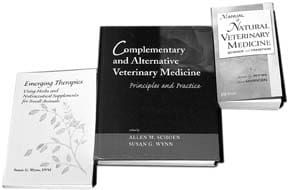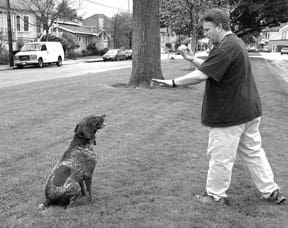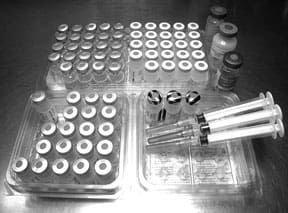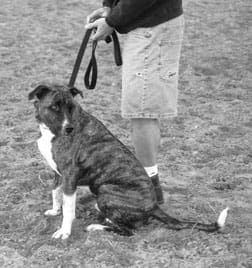[Updated March 22, 2018]
The pancreas is an elongated gland, light tan or pinkish in color, nestled alongside the small intestine and adjacent to the stomach. The organ is composed of two functionally separate types of glandular tissue, each which performs a vital and disparate role in the dog’s body.
Digestive Functions of the Pancreas in Dogs
“Exocrine” refers to the process of releasing outwardly through a duct, so the majority of pancreatic tissue is known as the exocrine pancreas, because its secretions are delivered through the pancreatic duct directly into the duodenum (small intestine), where they assist digestion.
The exocrine portion of the pancreas contains grape-like clusters of cells (called acinar cells), each of which can produce more than 10 different digestive enzymes. Pancreatic enzymes digest proteins, carbohydrates, and fats. Enzymes that digest proteins could potentially be harmful to the pancreatic cells themselves, so these enzymes are synthesized and stored until needed within the cells as protectively coated zymogen granules.
Enzymatic secretions from the acinar cell clusters pass through ducts lined with cells (centroacinar cells) that produce a watery secretion rich in sodium bicarbonate; pancreatic secretions thus have a basic pH to neutralize the highly acidic secretions of the stomach. And since both the pancreatic secretions and the bile from the liver empty into the upper portion of the small intestine, most of digestion occurs there.
The flow of pancreatic juices is stimulated by several mechanisms: the sight and smell of food, distention of the stomach, and release of partially digested foods from the stomach into the duodenum.
Each of these mechanisms stimulates the release of an appropriate enzyme, depending on the quantity and type of food ingested. Fatty foods, for example, stimulate a different enzymatic response than do proteinaceous foods. All enzymatic response is finally regulated by a feedback mechanism that produces enzymes when food is present and halts the production when the dog’s belly is empty and there is no food nearby.
The Endocrine Functions of the Pancreas
“Endocrine” glands do not have ducts, but release their secretions directly into the bloodstream and affect the function of specific target organs. The endocrine portion of the pancreas represents a much smaller percentage of the pancreatic tissue, but it plays an important role as the origin of several hormones, insulin most notable among them.
The endocrine portion of the pancreas is arranged into discrete islands, called the islets of Langerhans. Four different cell types make up these islands of endocrine tissue, and each produces a different hormone:
• Beta-cells are the most numerous and produce insulin;
• Alpha-cells produce glucagons;
• D-cells (sometimes referred to as Delta-cells) produce somatostatin; and
• F or PP cells produce pancreatic polypeptide.
While these hormones have different functions, they are all involved in the control of metabolism, especially glucose metabolism. I’ll discuss each hormone and its function in turn.
Insulin (produced by the Beta-cells) is amazingly similar between species. For example, cattle, sheep, horses, dogs, and whales differ only in the amino acids located at three sites (among a total of 21 amino acid sites) along one of the two protein chains that make up insulin. Canine insulin is similar to human insulin and identical to porcine insulin in its amino acid structure. (Feline insulin is most similar to bovine insulin.)
The function of insulin in animals is to facilitate the use of glucose, the primary source of energy from food. Its net effect is to lower blood concentrations of glucose, fatty acids, and amino acids, and to promote intracellular conversion of these compounds to their storage forms (i.e., glycogen from glucose, triglycerides from fatty acids, and protein from amino acids). The presence of insulin is critical to the movement of glucose through the cell’s outer membrane into the cell.
Insulin has many target organs and it affects nearly all cell types throughout the body, with the liver being an especially important target organ. Glycogen is a storage product of glucose metabolism, and insulin promotes its production in the liver, in fatty tissues, and in skeletal muscle.
Via several mechanisms, insulin promotes protein synthesis and inhibits protein degradation, thus promoting a positive nitrogen balance throughout the body. Additionally, insulin promotes the synthesis of adipose tissue (mature fat) from the fatty acids circulating in the blood.
The primary controlling factor for insulin secretion is the concentration of blood glucose; an increased concentration of blood glucose initiates the synthesis and release of insulin by the Beta-cells of the pancreatic islets. To a lesser extent, the presence of amino acids and fatty acids in the intestinal tract also stimulates the release of insulin. In all, at least a dozen factors influence insulin secretion, ranging from the type of diet to several hormones, and these all interact by stimulating or inhibiting production to create a whole-body energy balance.
Glucagon (produced by the Alpha-cells of the pancreatic islets) works in harmony with insulin in the control of glucose metabolism. Its main effects are the opposite of insulin. An increased activity of glucagon results in an increase of glucose in the blood.
Somatostatin is produced by the D-cells of the pancreatic islets and by areas of the gastrointestinal tract and parts of the brain. Somatostatin is an inhibitory hormone, and its main functions in the pancreas are to inhibit the secretion of insulin, glucagon, and pancreatic polypeptide. (In the gastrointestinal tract it decreases nutritive absorption and digestion and diminishes normal gut motility and secretory activity. In the brain it inhibits the secretion of growth hormone.)
A protein meal stimulates the production of pancreatic polypeptide, which is produced by the F cells of the pancreas. Pancreatic polypeptide inhibits the secretion of other pancreatic enzymes and increases the motility of the gut and the speed of gastric emptying.
In a healthy pancreas, the pancreatic hormones work together to maintain a harmonic and functional balance.
Pancreatic Problems in Dogs
The disease that results from pancreatic problems depends on what part of the pancreas is not working properly. First, let’s look at dysfunction arising from the exocrine pancreas.
Pancreatitis
Acute pancreatitis (inflammation of the pancreas) more commonly affects middle-aged to older dogs, obese dogs, and female dogs. The cause of pancreatitis is not often known, but localized trauma or the ingestion of a fatty meal are often implicated. The disease may be mild to severe. Complications may arise when the stored digestive enzymes (zymogens) are released into the pancreatic and surrounding tissues where they can cause an inflammatory reaction, and in severe cases they may begin to digest the dog’s own tissues.
Signs are often nonspecific and vary depending on the severity of the disease. A dog with mild pancreatitis may simply appear to have a “belly ache,” and mope around and lose her appetite for a day or two. More severe cases may include a sudden onset of vomiting, loss of appetite, depression, fever, abdominal discomfort, and dehydration. Symptoms may be severe enough to lead to shock and collapse.
Diagnosis is not always easy due to the nonspecific symptoms, but blood tests may be helpful. Serum amylase and lipase or the newer pancreatic lipase immunoreactivity (PLI) or pancreatic trypsin-like immunoreactivity (TLI) tests may be most useful. Radiographs, ultrasound, and CT scans may also be helpful.
Pancreatitis frequently recurs in those critters I refer to as “garbage hounds” – dogs who love to get into the household garbage pails and wolf down forbidden foods with glee. The tendency is for each bout of pancreatitis to be more severe than the one before; the theory is that these recurrences of acute pancreatitis – due to the repeated inflammation, immune response, and tissue necrosis and scarring they create – eventually lead to an increased risk for developing diabetes mellitus.
Treatment is generally nonspecific, varying with the severity of symptoms. A severe case of pancreatitis – intense vomiting, pain, etc. – is a medical emergency: See your vet as soon as possible. Pain control may be necessary, and intravenous fluids may be indicated in cases where shock is a possibility.
After a course of the disease, the pancreas should be rested by restricting food and water for 4 to 5 days. Particularly fatty foods should be severely reduced in the diet, and measures should be instituted to avoid the onset of diabetes: prevent obesity, plenty of exercise, and maintain a nonstressful, dog-friendly environment. The dog’s long-term prognosis may not be good, depending on the severity of the lesions suffered by the pancreas.
Exocrine Pancreatic Insufficiency
Exocrine pancreatic insufficiency (EPI) is caused by a deficiency of pancreatic digestive enzymes that eventually results in malnourishment. In dogs it appears most commonly in German Shepherds. Affected animals typically lose weight even though they have a ravenous appetite (these animals will often eat anything they can get their mouths around). They typically pass large volumes of semi-formed, greasy feces (since dietary fats are not being digested).
Fecal examination will often confirm the problem; your vet can check for undigested food particles and the presence of enzymes in the feces. Most dogs respond favorably when commercially available pancreatic enzyme supplements are added to the diet. However, since pancreatic tissue doesn’t regenerate, treatment will generally be lifelong.
Pancreatic Tumors
The most frequent pancreatic tumor is an islet cell carcinoma (insulinoma) derived from the insulin secreting Beta-cells. These tumors generally are found in dogs 5 to 12 years old; they are frequently hormonally active and secrete excessive amounts of insulin, causing hypoglycemia.
The resulting symptoms are those associated with low blood sugar, including muscular twitching and weakness, exercise fatigue, mental confusion, changes of temperament, and occasionally seizures. The symptoms often come and go, but they typically become worse and more frequent as the disease progresses.
Symptoms are easily confused with other primary neurological diseases such as epilepsy or brain tumors. Dogs with insulinomas typically have abnormally low (< 60 mg/dL) fasting blood glucose. Some veterinarians recommend that any older dog with neurological signs should have his blood glucose monitored.
Cancers of the exocrine pancreas are rare, but when they do occur, they can be aggressive and invasive.
Diabetes: the problem of the endocrine pancreas
Diabetes is a general term referring to disorders characterized by extreme thirst (polydipsia) and excessive urine excretion (polyuria).
The “diabetes” that most of us are familiar with is diabetes mellitus, which comes in several forms (including Type I, Type II, and Type III), all of which involve a relative or absolute insulin insufficiency. Since it is a condition of the pancreas, diabetes mellitus will be discussed here.
Much of the endocrine function of the pancreas is devoted to the production of insulin; 60 to 70 percent of the islet cell population are insulin-secreting Beta-cells. Insulin is the key factor in the metabolism of glucose (the energy-creating end-product of carbohydrate digestion), but insulin is also involved in the metabolic pathways of fats and proteins.
Glucose does not readily penetrate into cells (except for a few tissues such as the brain, liver, and blood cells); as stated earlier, insulin is critical for the movement of glucose through cell membranes into the cells. The net effects of insulin are to lower blood concentrations of glucose, fatty acids, and amino acids, and to promote intracellular conversion of these compounds to their storage forms (i.e., glycogen from glucose, triglycerides from fatty acids, and protein from amino acids).
The most important factor in the control of insulin secretion is the concentration of blood glucose; it is a positive feedback system in which increased concentrations of glucose (after a meal, for example) lead to increased secretion of insulin.
Diabetes mellitus is a insulin-deficient condition where there is either not enough insulin produced for the amount of glucose in the blood, or where the insulin that is produced is not functionally normal and thus is not able to produce the required cellular reactions.
Some breeds – notably Keeshonds, Pulis, Miniature Pinschers, and Cairn Terriers – seem to have a genetic predisposition to diabetes, and some, including Poodles, Dachshunds, Miniature Schnauzers, and Beagles, have an increased potential for developing the disease.
Symptoms of Diabetes in Dogs
As mentioned earlier, dogs with diabetes are forever thirsty, and as a consequence they urinate frequently.
The urine from dogs with diabetes mellitus animals will contain glucose. When the blood glucose levels exceed about 180 mg/dL, glucose begins to spill over into the urine, where it can be detected by urine dip sticks – or the good old taste test. If we were living in past centuries, we would simply dip our finger in the urine and taste it; today we have urine dipsticks that measure glucose content. Ancient practitioners also noted that bees were attracted to the urine from animals with diabetes mellitus.
Diabetes mellitus is a chronic and insidious disease. Although dogs are hungry and eat a lot, they lose weight and gradually become weaker. Muscle mass will gradually deteriorate, and the animal will not want to exercise.
The abnormal utilization of fat for energy may lead to an overproduction of ketones. Affected animals will often have the typical diabetic “fruity-sweet” smell of ketones. Note that only some people have the scent receptors that give them the ability to smell ketones; for others (I am one of the others) ketones are a “non-aroma.” Ketoacidosis is a severe overproduction of ketones and may cause disorientation, lethargy, and ultimately collapse. Test strips are available to detect the presence of ketones in the urine.
Many diabetic dogs develop cataracts, and the whitening of the eyes may be the first overt sign the caretaker notices.
Affected animals also become more susceptible to recurrent infections; cystitis, bronchitis, and skin problems are common, perhaps due to decreased neutrophil function associated with the excess of sugar in the blood. The liver, due to increased mobilization of body fats, may enlarge, and its function will be impaired by the fatty accumulations.
Human diabetic patients commonly incur retinitis and/or blood vascular conditions that may ultimately lead to limb amputations, but fortunately these two conditions are not common in diabetic dogs.
Canine Diabetes Mellitus Diagnosis
Diagnosing diabetes mellitus is based on persistent fasting hyperglycemia (blood glucose levels higher than normal) and glycosuria (the presence of glucose in the urine). The normal fasting value for blood glucose in dogs (and cats) is 75-120 mg/dL. Some animals may have a transiently high blood glucose level as a result of stress (especially cats), and some drugs (glucocorticoids and others) may elevate blood glucose levels.
There are two additional tests that may be helpful in diagnosis: serum glycosylated hemoglobin and fructosamine. These tests rely on the fact that glucose binds to many proteins in the body, and the “average” amount of glucose present in the blood over a period of time can be determined by evaluating its concentration on these proteins.
Glycosylated hemoglobin measures the average amount of glucose that the hemoglobin in red blood cells (RBCs) was exposed to over their lifespan, and since canine RBCs live for about 120 days, the measurement gives us a picture of average blood glucose levels over those past 120 days. Fructosamine measures glucose amounts bound to serum albumins; values indicate the average glucose concentration over the previous 1 to 2 weeks.
For diagnostic confirmation, to judge the severity of the disease, or (more commonly) to monitor the progress of the therapy being used to control the disease, your vet may want to do a glucose-tolerance curve, which is a way to test the animal’s efficiency in the removal of an excess of ingested glucose over a short period of time.
Diabetes Insipidus
Diabetes insipidus has nothing to do with blood sugar, insulin, or the pancreas. The only characteristic it shares with diabetes mellitus is that its victims experience extreme thirst and urination. In diabetes insipidus, this is due to the lack of antidiuretic hormone (ADH), which normally limits the amount of urine made, or by a failure of the kidneys to respond to ADH. Diabetes insipidus is treated with drugs that reduce the amount of urine made and/or help the kidneys respond to the ADH that is present.
Predisposing risk factors for diabetes in dogs:
Surveys indicate that extensive pancreatic damage, likely from chronic pancreatitis, causes about 28 percent of canine diabetes cases. Environmental factors such as feeding of high-fat diets and allowing the animal to become obese are associated with pancreatitis and therefore are likely to play a role in the development of diabetes in dogs.
Diabetes diagnosed in a female during pregnancy or diestrus is comparable to human gestational diabetes. Interestingly, at least one (human) study has shown that secondhand smoke is related to an increased incidence of diabetes, and other studies have demonstrated that correct dietary levels of calcium and vitamin D (or exposure to adequate sunlight) may help prevent diabetes.
While there is not yet any actual published data that show overt Type II diabetes occurs in dogs or that obesity is a risk factor for canine diabetes, an open-minded observation of the actual animals that have the disease leads me to believe that at least some dogs resemble the human Type II diabetes and that obesity is at least one of the causative factors involved in the development of the disease in dogs.
Diabetes Treatment for Dogs
Successful therapy, no matter the course chosen, will require that the dog’s caretakers be willing to undertake long-term and vigilant monitoring of blood glucose levels. They should also should endeavor to thoroughly understand how both the disease and its treatments work, so they will know, by the symptoms of the dog, when to change the rate or dosage of the medicines. They must be willing to give daily insulin injections (if necessary), and be prepared to deal with a hypoglycemic crisis if it occurs from an insulin overdose.
Conventional treatment begins with a combination of weight reduction and diet (high in fiber and complex carbohydrates). Intact females should be spayed, as their blood sugar may prove more difficult to control during estrus.
If diet and weight reduction do not control the disease, injectable insulin will be necessary. There are more than 20 forms of injectable insulin available, with several made especially for dogs. Each form of insulin has a unique time of onset and duration of activity. Your vet will likely recommend the one with which she is most familiar and successful. Insulin injections may be required once or twice daily.
Types of Diabetes and the Need for Insulin in Diabetic Dogs
In humans there are fairly distinct types of diabetes. The most common are Type I diabetes (insulin-dependent diabetes mellitus or IDDM), and Type II diabetes (non-insulin-dependent diabetes mellitus or NIDDM). A third type, latent autoimmune diabetes of adults (LADA), occurs as a slowly progressive disease that shows up in middle-aged or older people. About 90 percent of all human cases are Type II; the cases in most dogs more closely resemble the human Type I or the LADA type.
“Gestational diabetes” (frequently called Type III diabetes) affects pregnant women (about 4 percent) and other pregnant animals. Its cause is unknown, but it is likely related to the mother’s hormone changes and the interactions between the hormones of the mother and the baby that occur during pregnancy. This type of diabetes generally responds to dietary therapy, and it usually goes away after pregnancy.
Type I diabetes is the result of a lack of insulin production due to the destruction of pancreatic Beta-cells; in humans it typically occurs in younger patients; and it is not usually associated with obesity. It is not clear what causes Type I diabetes, but it is likely an autoimmune disease.
Type II diabetes is typically associated with obesity. Here, a lack of sufficient insulin is not the problem. However, problems arise because the insulin that is produced does not interact with its target cells properly.
Human patients with Type I diabetes will almost always require insulin injections, whereas many Type II diabetics can be treated with dietary and lifestyle changes, possibly with the addition of minimal use of injectable insulin.
Most veterinary endocrinologists think that a majority of diabetic dogs have Type I diabetes, since most show serum antibodies to insulin – the keynote of Type I in humans.
All well and good…except that, by definition, Type I diabetes is a due to a lack of insulin production, and this often leads the practitioner to the conclusion that all diabetic dogs will require insulin therapy. My experience would indicate that some diabetic dogs respond quite nicely to alternative medicines, coupled with nutritional therapies and lifestyle changes.
Since this is true, I see absolutely no reason to avoid alternative therapies at the outset of the disease. You can always go to the injectable insulin if it is needed after a few months or so.
I agree with the endocrinologists who think most dogs have something more like the LADA form, given that most are middleaged dogs with a slow onset of the disease.
Holistic Diabetes Treatment for Dogs
Nonconventional therapies for diabetes run the usual gamut of medicines, including acupuncture, homeopathy, herbal, and nutritional therapies. Life style changes will almost certainly be needed; more exercise to reduce weight and attention given to reducing stress are commonly prescribed. Therapies such as calming herbs, massage, flower essences, and aromatherapy may be indicated to reduce the dog’s stress.
For the obese animal, specific nutritional supplementation should include a high fiber, weight-reducing diet. There are some commercial products available that purport to be supportive of diabetic animals. Check with your holistic veterinarian.
Niacin (vitamin B-3) plays an important role in carbohydrate metabolism, and research shows that one of its precursors, niacinamide (the substance found in most “enriched” grains), can protect pancreatic cells from diabetes-inducing factors. Biotin and vitamin B-6 are also important nutrients in carbohydrate metabolism and for helping prevent diabetic complications.
Vitamin E has been shown to reduce blood sugar levels in diabetics, and thiamine plays a huge role in the proper regulation of glucose metabolism and pancreatic Beta-cell function. Vitamin C is important for blood sugar regulation in humans and animals; supplementation with vitamin C has been shown to decrease insulin resistance and improve glucose regulation (in mice).
Poor control of diabetes has been associated with low serum magnesium, and as already mentioned, low levels of calcium and vitamin D are associated with increased chances for developing diabetes. Zinc and selenium, too, have a proven role in preventing diabetes. Chromium, in just micro doses, appears to be very helpful for some cases of diabetes. Chromium picolonate is the biologically active form, and its action is to increase the number of cell receptors for insulin; it would thus be most helpful for Type II diabetes.
Note: In all cases of nutrient supplementation, be certain that you are providing a balanced level of the nutrients. Check with your holistic veterinarian to be sure.
Worldwide there have been more than 1,200 herbs that have been used to treat diabetes. Out of these, several have shown promise on animals, including: fenugreek, dandelion, garlic, cinnamon, and Madagascar periwinkle. Ask a qualified herbalist who has worked with animals for correct dosages and ways to use the herbs.
I have had success when using classical homeopathy and acupuncture with diabetic patients. Admittedly my cure rates were not as high as with other diseases, but they were high enough to justify the recommendation to try an alternative approach initially.
One final caveat: Diabetes may be the most-discussed disease on this planet – meaning the Internet is chock full of information (correct and incorrect), good and bad advice, cure-all proclamations, and downright hooey. You can learn a lot about diabetes on the Internet, but … buyer and user beware!
PANCREAS HEALTH AND DIABETES IN DOGS: OVERVIEW
1. Don’t allow your dog to become overweight. Obese dogs have a higher risk of pancreatitis and diabetes.
2. If your dog has had pancreatitis, control his food intake, level of dietary fat, and potential access to garbage or forbidden foods to prevent another attack.
3. If your diabetic dog’s blood sugar levels are not too extreme, consider trying to control his diabetes with diet and complementary therapies.
Dr. Randy Kidd earned his DVM degree from Ohio State University and his PhD in Pathology/Clinical Pathology from Kansas State University. A past president of the American Holistic Veterinary Medical Association, he’s author of Dr. Kidd’s Guide to Herbal Dog Care and, Dr. Kidd’s Guide to Herbal Cat Care.























